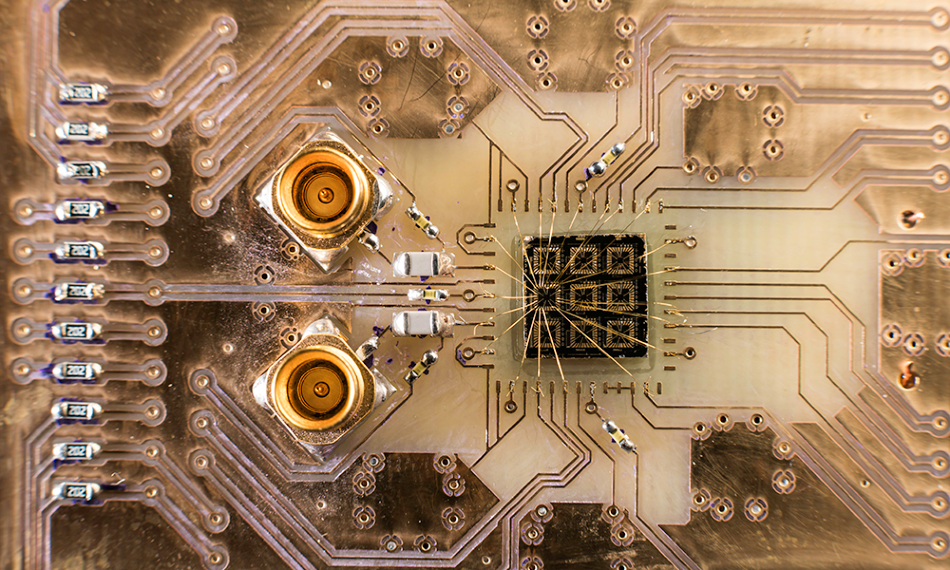Jun 22 2020
One famous catchphrase in the Star Trek series is “beam me up.” This command is issued when a certain character wants to teleport from a distant site back to the Starship Enterprise.
 A quantum processor semiconductor chip is connected to a circuit board in the lab of John Nichol, an assistant professor of physics at the University of Rochester. Nichol and Andrew Jordan, a professor of physics, are exploring new ways of creating quantum-mechanical interactions between distant electrons, promising major advances in quantum computing. Image Credit: University of Rochester photo/J. Adam Fenster.
A quantum processor semiconductor chip is connected to a circuit board in the lab of John Nichol, an assistant professor of physics at the University of Rochester. Nichol and Andrew Jordan, a professor of physics, are exploring new ways of creating quantum-mechanical interactions between distant electrons, promising major advances in quantum computing. Image Credit: University of Rochester photo/J. Adam Fenster.
Although science fiction is one genre where human teleportation is known to exist, teleportation can be realized in the subatomic realm of quantum mechanics—although not in the manner usually shown on televisions. Teleportation in the quantum realm involves the transportation of data, instead of the transportation of matter.
Researchers confirmed the previous year that even when the photons were not physically connected, data could still be passed between photons on computer chips. And now, teleportation could also be achieved between electrons, according to the latest study conducted by the University of Rochester and Purdue University.
In a study published in the Nature Communications journal and one that would soon be published in the Physical Review X journal, the scientists, including John Nichol, an assistant professor of physics at the University of Rochester, and Andrew Jordan, a professor of physics at the University of Rochester, looked for novel ways of producing quantum-mechanical communications between remote electrons.
The study is a major step in enhancing quantum computing, which, consecutively, has the ability to redefine science, medicine, and technology by offering sensors and processors that are faster and more efficient.
“Spooky Action at a Distance”
Quantum teleportation is essentially a demonstration of what Albert Einstein popularly referred to as “spooky action at a distance”—also called quantum entanglement. In entanglement—one of the underlying theories of quantum physics—the characteristics of one particle have an impact on the characteristics of another, even when a large distance separates the particles.
In quantum teleportation, a pair of remote and entangled particles is involved where the state of a third particle rapidly “teleports” its state to the pair of entangled particles.
Quantum teleportation presents a significant way of conveying data in quantum computing. Although a standard computer contains an unlimited number of transistors, known as bits, quantum computers are capable of encoding data in quantum bits, or qubits.
A single bit contains one binary value, which can be either “1” or “0,” but qubits can be both “1” and “0” simultaneously. The potential for individual qubits to concurrently occupy numerous states underscores the excellent potential power of quantum computers.
Researchers have now shown quantum teleportation and they did this by making use of electromagnetic photons to produce distantly entangled qubit pairs. But qubits made from separate electrons also show promise for relaying data in semiconductors.
Individual electrons are promising qubits because they interact very easily with each other, and individual electron qubits in semiconductors are also scalable. Reliably creating long-distance interactions between electrons is essential for quantum computing.
John Nichol, Assistant Professor of Physics, University of Rochester
Producing entangled pairs of electron qubits that cover long distances—needed for teleportation—has demonstrated to be rather difficult: while photons naturally spread across extended distances, electrons are often limited to a single place.
Entangled Pairs of Electrons
With the help of electrons, the researchers demonstrated quantum teleportation by harnessing a newly created method. This method is based on the principles of Heisenberg exchange coupling. A separate electron is similar to a bar magnet with a south pole or a north pole pointing either in the upward or downward direction. The direction of the pole—for example, whether the north pole is pointing in the upward or downward direction—is called the electron’s quantum spin state or magnetic moment.
If specific kinds of particles exhibit the same magnetic moment, they cannot remain in the same location simultaneously. In other words, a pair of electrons exhibiting the same quantum state cannot sit over one another. If at all they did, their states would switch to and fro in time.
Using the technique, the scientists distributed the entangled pairs of electrons and subsequently teleported their spin states.
We provide evidence for ‘entanglement swapping,’ in which we create entanglement between two electrons even though the particles never interact, and ‘quantum gate teleportation,’ a potentially useful technique for quantum computing using teleportation. Our work shows that this can be done even without photons.
John Nichol, Assistant Professor of Physics, University of Rochester
The study’s results present new avenues for upcoming studies on quantum teleportation that involve spin states of all matter, and not simply photons. They also offer more proof for the unexpectedly handy capabilities of separate electrons present in qubit semiconductors.
Journal Reference:
Qiao, H., et al. (2020) Conditional teleportation of quantum-dot spin states. Nature Communications. doi.org/10.1038/s41467-020-16745-0.